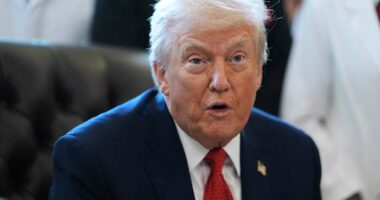Share this @internewscast.com

Six months after President Donald Trump began implementing significant tariffs on imports, a report from Goldman Sachs analysts indicates that U.S. consumers are bearing approximately 55% of these costs.
And with new tariffs likely on the way, the cost burden could rise even higher, they said.
The report, published on Sunday, implies that American consumers might continue to face elevated prices, despite Trump’s previous vow to alleviate economic strains ahead of his re-election. Although inflation has decreased from the high levels experienced after the Covid pandemic, it remains above what experts deem healthy, leading both consumers and businesses to feel the pinch of rising prices.
Since the tariffs’ introduction, Trump has targeted copper, steel, aluminum, and certain vehicles and parts, alongside imposing specific tariff rates of up to 28% on China and 16% on many other countries, based on data from the Yale Budget Lab.
Consequently, consumer prices reported by the Bureau of Labor Statistics (BLS) have seen a continuous rise each month following Trump’s “Liberation Day” address that revealed the new tariffs. By August, the BLS reported that the Consumer Price Index (CPI) had reached 2.93%. The release of September’s CPI has been delayed due to the ongoing government shutdown, now entering its 13th day, and is expected later this month.
Another inflation measure, which is favored by the Federal Reserve, also increased to 2.7% in August, surpassing the central bank’s 2% goal.
In August, Trump criticized an earlier estimate from Goldman Sachs, which projected that consumers could face up to 67% of the tariff costs. However, a statement from the White House was not available for comment on Monday.
The administration has pointed to the billions in revenues the duties have brought in to continue to justify their existence. In September, tariff revenues totaled more than $31 billion, bringing the year-to-date haul to about $215 billion. Trump has floated various proposals for how to use the funds, including sending out rebate checks to U.S. households and subsiding U.S. farmers and manufacturers. Last week, White House Press Secretary Karoline Leavitt indicated the administration would use some tariff revenues to pay for Special Supplemental Nutrition Program for Women, Infants, and Children food subsidies that have been affected by the shutdown.
The Goldman analysts arrived at their estimate of the tariffs’ burden on consumers by comparing how much consumer prices for tariffed products have deviated from previous trends. The burden is actually less than the estimated pass-through that occurred during the trade war Trump set off during his first term in 2018. In that period, evidence suggests foreign exporters did not bear any significant share of the tariff costs at the time, meaning consumers were shouldering even more of a burden.
This time, exporters are bearing some cost, along with U.S. businesses, who may actually be sparing consumers even worse price increases for the moment. American companies may be waiting to see how the U.S. Supreme Court rules on tariffs, the Goldman analysts said. Businesses also might have accumulated inventory in advance of the tariffs setting in, allowing them to hold off on raising their retail prices more significantly. The nation’s highest court is set to hear opening arguments in the tariff case Nov. 5.
Still, the analysts estimate tariffs have added 0.44% to the Fed’s preferred inflation measure. That figure could rise to as much as 0.6% if Trump makes good on recent threats to impose tariffs on products such as furniture and kitchen cabinets. Those were set to take effect Tuesday. In this scenario, the tariffs’ cost burden borne by consumers could rise to 70%.
The analysts’ latest estimate does not take into account Trump’s threat Friday to double the tariffs on China. On Monday, Trump administration officials sought to reassure markets that they did not seek to reignite tensions with America’s largest overseas trading partner
If those tariffs were to take effect, the impact would be significant, the analysts said.
“We are not assuming any changes to tariff rates on imports from China, but events in recent days suggest large risks,” they wrote.













